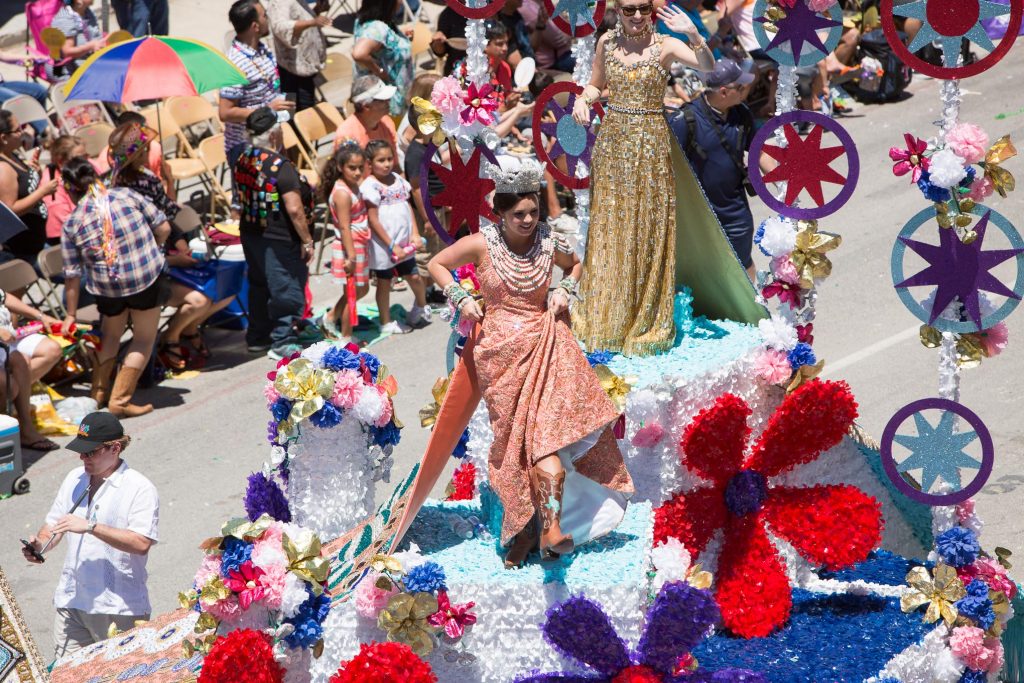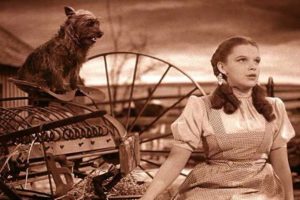Colorful floats; streets closed with barricades; people covering the sidewalks and setting up their lawn chairs to have a good view, having the day off from school; the Marching Bands from High Schools and Universities, decorating their instruments with ribbons, preparing their formation under Highway 37 on Grayson Street; the Fiesta Royalty putting on their best pairs of decorated shoes before stepping onto their throne, mounted on one of the biggest of the parade floats. If you’re a native San Antonian, you know exactly what grand celebration is about occur and what has been going on for the days before; it is part of Fiesta, the ten-day city-wide celebration; it is the Battle of Flowers parade. The Battle of Flowers is a 2.6-mile parade that runs through downtown San Antonio, typically one of the closing events of the Fiesta celebration. This Parades begins on the edge of downtown, and continues onto three major streets: Broadway, Alamo, and Commerce.1 Local schools participate in this parade; their dance troops, mariachi bands, ROTC, and Marching Band programs participate and walk the parade alongside the Texas Cavaliers, the Fiesta Royalty, and the Mayor. Although this annual event has become a hallmark for San Antonians, many don’t know how or when it all began. Let’s go back to its origins, back to the last decade of the nineteenth century in San Antonio.

Originating in 1891, the Battle of Flowers parade was created as a tribute to all those who fought and who fell at the Battles of San Jacinto and the Alamo.2 The idea of a grand celebration to commemorate these heroes came from a tourist, the native-Chicagoan W. J. Ballard. He believed that a proper tribute should be made, and asked a group of local ladies why this had not been the case just yet. His question extended through the city and made its way into newspapers and gained the approval of the community almost instantly. The anticipated idea aroused a spark of interest in Ellen Maury Slayden, a native Virginian elite, who had found her way to San Antonio by marriage to a merchant and later congressman, James L Slayden. Slayden then decided to bring Ballard’s idea to life, and since she knew it was almost impossible on her own, she decided to enlist the help of another newcomer to the area, J. S. Alexander. They both decided to take this on as a pet project of theirs, with the help and support of their husbands. Alexander, a banker before arriving in Texas, provided information on some familiarity he had had overseas about seeing a parade surrounded by flowers, where carts were decorated with flowers. Slayden also remembered similar instances in celebrations she knew about across Mexico and Spain, giving the basis for what the parade would become. The husbands, and many of the elite men of San Antonio, took over the project and had gentlemen speak on behalf of the ladies at the committee meetings; however, as the project grew, the ladies wanted to make sure that it was still a women’s project and continued to provide input and ideas, thus creating the Battle of Flowers Association.3

The parade was originally intended to be an April 21st celebration to celebrate the 55th anniversary of the victory of the Battle of San Jacinto; however, coincidentally, San Antonio was just then expecting its first-ever visit from the White House, the 23rd president of the United States, President Benjamin Harrison. As soon as word got out, the city became ecstatic and prepared a celebration to welcome the President, including moving the parade a day ahead of its original date. With the dates set in stone, the first official planning committee meeting took place only a mere seven days prior to the event. They were frantically trying to gather flowers from nearby towns, since San Antonio had just experienced some heavy rains, which had destroyed most flower gardens, leaving the city with a shortage of flowers just before the parade. Trains were rushed in with shipments of flowers from nearby towns. Other means of making up for the shortage were discussed as well, such as dressing the children up as flowers and having bicyclists decorate their mobiles with whatever blossoms they found and join the parade.4 In the days leading up to the parade, everything seemed all set to go, except for the weather. The city had been plagued with days of heavy rain, and the whole city was hopeful that the rains would cease as the day approached; however, they were wrong. On the morning of the parade, the rains didn’t have mercy on their plans, and as the President’s train arrived, the downpour became continuous. But the rains didn’t stop the city from providing the President with a warm welcome; however, it did postpone the flower parade for the following week, which, of course, would mean that the President would be long gone by then. When the warm weather finally arrived the following week, the parade went as planned; and it was so successful that the committee pushed to have it continue as an annual celebration. It has since been celebrated since 1891, except for the years during World Wars I and II.5

By 1985, the parade continued to grow into the week-long celebration known today as Fiesta. And as the years went by, Kings and Queens were elected as Fiesta Royalty.6 The Parade continues to grow, and so does its recognition across the city and the state. It is now funded by private associations. To this day the parade is one of the closing events of the city-wide, week-long Fiesta party and continues to generate community involvement. Every April, San Antonio puts on a fantastic show, and without a doubt, it all goes back to a Chicagoan tourist, two ladies, and one united community.

- Battle of Flowers, Official Website: Battle of Flowers About us (battleoflfowers.org, 2018). ↵
- Handbook of Texas, June 2010, s.v “Fiesta San Antonio,” by Mrs. Willard E. Simpson, Jr. ↵
- Jack Maguire, A Century of Fiesta in San Antonio (Austin, Texas: Eakin Press, 1990), 13-15. ↵
- Jack Maguire, A Century of Fiesta in San Antonio (Austin, Texas: Eakin Press, 1990), 17. ↵
- Jack Maguire, A Century of Fiesta in San Antonio (Austin, Texas: Eakin Press, 1990), 17; Laura Hernandez-Ehrisman, Inventing the Fiesta City, Heritage and Carnival in San Antonio (New Mexico Press,2008), 21. ↵
- Handbook of Texas, June 2010, s.v. “Fiesta San Antonio,” by Willard E. Simpson, Jr. ↵



117 comments
Indhira Mata
Coming to San Antonio, one of most talked events is Fiesta. I never knew or understood what Fiesta was until I read the article. I enjoy to see all the history San Antonio has. It shows that the people has a lot of culture and attachment to their city. The article not only showed how the city got together to celebrate a historical point, but also a change in the role of women. This project started of as a women’s project and it allowed them to make an impact in their city.
Kaitlyn Killebrew
I have lived in San Antonio all of my life and Fiesta is one of my favorite holidays. Seeing the entire city lit up in bright colors and flowers, it’s basically a Christmas in spring for us San Antonians. We would even do little parades in elementary school. Each student would create a small float and take it down the hallways, it was always so much fun. I had always loved being in San Antonio but the culture here is always so breathtaking. Please if you get the chance go downtown to market street for Fiesta, but don’t go at night. Being in band has allowed me to perform in the Battle of Flowers parade for Four years and unless you are twenty-one and older, there’s not a lot to do at night. I knew that we celebrated for the soldiers from San Jacinto and the Alamo, but had no clue that the idea came from a tourist from Chicago.
Jennifer Salas
I’m new to San Antonio, and I have heard about this festival before but never knew the origins of it. I find it so amazing that the tradition is still going on, and so empowering that women were a huge contributing factor. After reading this article I hope to attend this event now that I know how it was created. I’m glad that I read this article because it was so informative and I learned so much about a city I now call home.
Gabriela Ochoa
Having just moved here from Austin and not visiting much I have never heard of this festival. its interesting that the origin of the festival was originally started by people who aren’t originally from San Antonio but decided to help those that are celebrate in their history. The fact that they only gave themselves seven days to plan was amazing that they were able to accomplish so much in such a short amount of time. Can’t wait to experience this next semester.
Tyler Boyd
Not being from San Antonio I had no idea that this was a thing until reading this article. I think it is an interesting tradition and am happy that it is still going strong. What I find most interesting is the origin, I can’t believe that they only gave themselves seven days to plan such a large event. What is even more interesting is that they pulled it off and are still going strong more than 100 years later. I can’t wait to experience this in person next year.
Jabnel Ibarra
This article is amazingly structured as well as informative. The way information is presented and the flow of the paragraphs maintains the reader’s interest while describing the origins of the city-wide festival and contextualizing its creation with historical figures and events from the time period. The fact that the idea of the Battle of the Flowers was presented by a tourist and not a local was something I actually didn’t know, and something about that fun fact makes me appreciate the festival that much more.
Katherine Watson
Even after 127 years, San Antonio remains true to its roots and continues to show appreciation for the people who founded our beliefs. Fiesta is so much more than the city shutting down for a week for tourists to eat a chicken on a stick. We unite as a city because of two individuals who had a dream for celebration and tribute to those who fought for us.
Yadira Chavez
I first experienced this really fun festival a few months ago in San Antonio, as I was born and raised in El Paso. I think this article is really neat because i truly never knew where it came from. It reminded me of being home, especially because we have a festival called Fiesta De Las Flores, also created by the women of El Paso, so it makes me really want to go this coming year and enjoy the history behind all of it!
Aneesa Zubair
My parents own a business in downtown San Antonio, so I’ve always known Fiesta and Battle of Flowers as one of the busiest times of year. Since I was little, I kind of knew the celebration had something to do with commemorating a battle, but not much else. This article made me realize how little I knew, even as a native San Antonian. It was really surprising to find out that the idea was conceived by a tourist from Chicago and a newcomer from Virginia!
Eric Ortega Rodriguez
I am not from San Antonio but had always heard about Fiesta and San Antonio’s Battle Of Flowers and the great amounts of fun it is. I found this article very informative because I hope to attend this event in the future and it is fascinating to learn about the background before actually experiencing it. It is incredible to see how this event can connect people and build a strong community. The images selected in the articles were spot on because, as a person who has never gone to this event, it helped to visualize how beautiful this event must be in person. I found it interesting that Ellen Maury Slayden was the first to ignite this event. It just proves to show how much one can fall in love with the beautiful city of San Antonio.